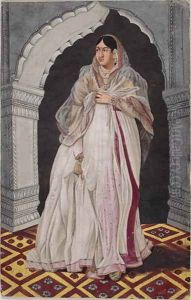Mihr Chand Paintings
Mihr Chand, born in 1737, was a distinguished Indian miniature painter, primarily active during the late 18th century in the princely state of Jammu and Kashmir, under the patronage of the local rulers. His work is notably a blend of the Pahari painting style, which flourished in the Himalayan hill states, and the Mughal artistic tradition that dominated the Indian subcontinent from the 16th to the 19th centuries. Despite the limited information on his personal life, Mihr Chand's contributions to Indian art history are significant, particularly in the context of regional styles' interactions with the broader Mughal influence.
Mihr Chand's artistic journey is emblematic of the period's complex socio-political and cultural dynamics, wherein local artists often navigated between regional traditions and the pervasive influence of the Mughal court's aesthetic preferences. His works are characterized by intricate detailing, vibrant colors, and a harmonious blend of naturalistic Mughal elements with the spiritual and romantic themes typical of Pahari paintings. This synthesis not only highlights Mihr Chand's mastery over his craft but also reflects the broader trends of cultural exchange and synthesis within the Indian subcontinent during the 18th century.
Throughout his career, Mihr Chand's patronage under the rulers of Jammu and Kashmir allowed him a degree of artistic freedom and stability, enabling him to develop a distinctive style that attracted admiration from contemporaries and later art historians alike. His legacy, while not as widely recognized as that of some of his Mughal or Rajput counterparts, remains an essential part of the study of Indian miniature painting, offering insights into the nuanced interplay of regional and imperial art forms in pre-colonial India. Mihr Chand passed away in 1795, leaving behind a body of work that continues to be celebrated for its aesthetic beauty and historical value.
